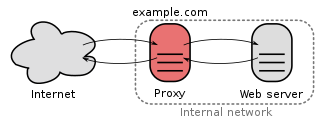Related Research Articles

Hypertext Transfer Protocol Secure (HTTPS) is an extension of the Hypertext Transfer Protocol (HTTP). It uses encryption for secure communication over a computer network, and is widely used on the Internet. In HTTPS, the communication protocol is encrypted using Transport Layer Security (TLS) or, formerly, Secure Sockets Layer (SSL). The protocol is therefore also referred to as HTTP over TLS, or HTTP over SSL.

In computing, load balancing is the process of distributing a set of tasks over a set of resources, with the aim of making their overall processing more efficient. Load balancing can optimize response time and avoid unevenly overloading some compute nodes while other compute nodes are left idle.
Transport Layer Security (TLS) is a cryptographic protocol designed to provide communications security over a computer network, such as the Internet. The protocol is widely used in applications such as email, instant messaging, and voice over IP, but its use in securing HTTPS remains the most publicly visible.
SOCKS is an Internet protocol that exchanges network packets between a client and server through a proxy server. SOCKS5 optionally provides authentication so only authorized users may access a server. Practically, a SOCKS server proxies TCP connections to an arbitrary IP address, and provides a means for UDP packets to be forwarded. A SOCKS server accepts incoming client connection on TCP port 1080, as defined in RFC 1928.

A content delivery network or content distribution network (CDN) is a geographically distributed network of proxy servers and their data centers. The goal is to provide high availability and performance ("speed") by distributing the service spatially relative to end users. CDNs came into existence in the late 1990s as a means for alleviating the performance bottlenecks of the Internet as the Internet was starting to become a mission-critical medium for people and enterprises. Since then, CDNs have grown to serve a large portion of the Internet content today, including web objects, downloadable objects, applications, live streaming media, on-demand streaming media, and social media sites.

lighttpd is an open-source web server optimized for speed-critical environments while remaining standards-compliant, secure and flexible. It was originally written by Jan Kneschke as a proof-of-concept of the c10k problem – how to handle 10,000 connections in parallel on one server, but has gained worldwide popularity. Its name is a portmanteau of "light" and "httpd".

In computer networks, a reverse proxy or surrogate server is a proxy server that appears to any client to be an ordinary web server, but in reality merely acts as an intermediary that forwards the client's requests to one or more ordinary web servers. Reverse proxies help increase scalability, performance, resilience, and security, but they also carry a number of risks.
Push technology, also known as server Push, refers to a communication method, where the communication is initiated by a server rather than a client. This approach is different from the "pull" method where the communication is initiated by a client.
Hiawatha was a free and open source cross-platform web server developed by Hugo Leisink.
Nginx is a web server that can also be used as a reverse proxy, load balancer, mail proxy and HTTP cache. The software was created by Russian developer Igor Sysoev and publicly released in 2004. Nginx is free and open-source software, released under the terms of the 2-clause BSD license. A large fraction of web servers use Nginx, often as a load balancer.
An application delivery controller (ADC) is a computer network device in a datacenter, often part of an application delivery network (ADN), that helps perform common tasks, such as those done by web accelerators to remove load from the web servers themselves. Many also provide load balancing. ADCs are often placed in the DMZ, between the outer firewall or router and a web farm.
SPDY is an obsolete open-specification communication protocol developed for transporting web content. SPDY became the basis for HTTP/2 specification. However, HTTP/2 diverged from SPDY and eventually HTTP/2 subsumed all usecases of SPDY. After HTTP/2 was ratified as a standard, major implementers, including Google, Mozilla, and Apple, deprecated SPDY in favor of HTTP/2. Since 2021, no modern browser supports SPDY.
The Transport Layer Security (TLS) protocol provides the ability to secure communications across or inside networks. This comparison of TLS implementations compares several of the most notable libraries. There are several TLS implementations which are free software and open source.
Web performance refers to the speed in which web pages are downloaded and displayed on the user's web browser. Web performance optimization (WPO), or website optimization is the field of knowledge about increasing web performance.
HTTP/2 is a major revision of the HTTP network protocol used by the World Wide Web. It was derived from the earlier experimental SPDY protocol, originally developed by Google. HTTP/2 was developed by the HTTP Working Group of the Internet Engineering Task Force (IETF). HTTP/2 is the first new version of HTTP since HTTP/1.1, which was standardized in RFC 2068 in 1997. The Working Group presented HTTP/2 to the Internet Engineering Steering Group (IESG) for consideration as a Proposed Standard in December 2014, and IESG approved it to publish as Proposed Standard on February 17, 2015. The initial HTTP/2 specification was published as on May 14, 2015.
Application-Layer Protocol Negotiation (ALPN) is a Transport Layer Security (TLS) extension that allows the application layer to negotiate which protocol should be performed over a secure connection in a manner that avoids additional round trips and which is independent of the application-layer protocols. It is used to establish HTTP/2 connections without additional round trips.
QUIC is a general-purpose transport layer network protocol initially designed by Jim Roskind at Google. It was first implemented and deployed in 2012 and was publicly announced in 2013 as experimentation broadened. It was also described at an IETF meeting. The Chrome web browser, Microsoft Edge, Firefox, and Safari all support it. In Chrome, QUIC is used by more than half of all connections to Google's servers.
Caddy is an extensible, cross-platform, open-source web server written in Go.
Angular is a TypeScript-based free and open-source single-page web application framework. It is developed by Google and by a community of individuals and corporations. Angular is a complete rewrite from the same team that built AngularJS. The Angular ecosystem consists of a diverse group of over 1.7 million developers, library authors, and content creators. According to the Stack Overflow Developer Survey, Angular is one of the most commonly used web frameworks.
H2O is a free and open-source web server. It is written in C, and is distributed under the terms of the MIT License.
References
- ↑ "Image Optimization for e-Commerce". ShimmerCat. Archived from the original on 2022-03-31. Retrieved 2022-04-13.
- ↑ "A closer look to HTTP/2 Push". ShimmerCat. Archived from the original on 2021-03-04. Retrieved 2022-04-13.
- ↑ "What is SOCKS5 Proxy: Things Need to Know" . Retrieved 2024-12-16.
- ↑ "Easy net with SOCKS5". ShimmerCat. Archived from the original on 2019-07-19. Retrieved 2022-04-13.
- ↑ "TLS has exactly one performance problem: it is not used widely enough". Is TLS Fast Yet?. Archived from the original on 2022-04-01. Retrieved 2016-10-16.
- ↑ Grigorik, Ilya [@igrigorik] (2016-04-29). "leveraging HTTP/2 flow control + prioritization for optimized image loading: http://bit.ly/1T8ZasU - awesome" (Tweet) – via Twitter.
- ↑ Smashing Magazine [@smashingmag] (2016-05-03). "ShimmerCat is the first web server to allow for manual allocation of bandwidth for images over HTTP/2 connections. https://shimmercat.com/en/info/articles/coordinated-image-loading/" (Tweet) – via Twitter.